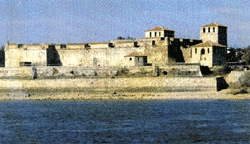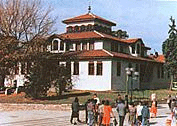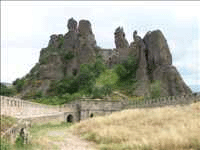
|

The
municipality
of
Vidin
is
located
in
the
northwestern
part
of
the
Danubian
Plain.
Its
territory
coincides
with
the
Vidin
Lowland,
between
the
bend
of
the
Danube
at
Vidin
and
the
hills
to
the
southwest.
The
city
of
Vidin,
at
the
bank
of
the
Danube,
is
the
municipal
capital.
Vidin
is
located
in
the
lowest
terrace
of
the
Vidin
Lowland,
35
meters
above
sea
level,
with
a
slight
north-northeast
grade
(0.5%
to
4%).

Vidin
has
a
semi-circular
shape,
with
streets
and
buildings
oriented
to
the
river.
A
large
park
with
beaches
and
recreation
areas
is
located
along
the
riverbank.
The
municipality’s
total
area
is
501,281
decares,
of
which:
374,416
decares
of
agricultural
land
(incl.
337,207
decares
of
arable
land);
44,011
decares
of
forests;
33,506
decares
of
water
areas;
14,974
decares
of
irrigated
areas;
and
43,639
decares
populated
areas.
Vidin
has
two
summer-house
areas,
the
Bozhuritsa
area
(grade
I)
and
Sinagovsko
Burdo
(grade
II).
The
distance
to
Bulgaria’s
capital,
Sofia,
is
200
kilometers.
Geographically,
the
municipality’s
location
makes
it
well-accessible
and
predetermines
its
importance
to
the
national
and
the
European
transport
systems.
The
north-south
transport
corridor
No.
4 is
the
shortest
road
connecting
the
countries
in
Western,
Middle
and
Eastern
Europe.
Being
an
important
transport
hub
is a
great
resource
and
a
prerequisite
for
the
construction
of a
second
bridge
over
the
Danube.
Municipality of Vidin is located 200 kilometers away from Bulgaria’s capital, Sofia. Its location makes it easily accessible and determines its importance for the national and the European transport networks.
Two
European
transport
corridors
cross
the
municipality:
No.
4 -
Kraiova
(Romania)
-
Vidin
-
Sofia
-
Koulata;
and
No.
7
along
the
Danube.
The
city
of
Vidin
is
the
best
place
for
the
construction
of a
second
bridge
on
the
Danube.
The
EU
has
made
a
decision
that
will
make
the
bridge
a
reality.
The
Vidin
North
port
is
located
close
to
the
city,
on a
9
kilometer
section
along
the
riverbank,
in
the
immediate
vicinity
of
the
ferryboat
and
the
duty
free
zone.
Municipality
of
Vidin
is
connected
to
all
communities
within
the
country
and
to
the
border
checkpoints
via
roads
and
railroads.
Railroads
have
a
great
importance
for
the
municipality.
On
the
average,
10
trains
depart
and
arrive
at
the
Vidin
passenger
train
station.
The
freight
train
station
is
comparatively
new,
on
an
area
of
230
decares.
Its
capacity
is
20-30
tons
of
loading/unloading
works
and
freight
processing
per
day.
At
present,
it
is
not
being
utilized
at
full
capacity.

The
Fortress
of
Belogradchik
is
an
impressive
architectural-constructional
and
historical
monument
of
the
culture.
It
is
situated
in
the
south
of
Vidin
between
Peak
Kom
and
Peak
Vrushka
Chuka.
The
slender
silhouette
of
the
fortress
enters
perfectly
in
the
space
surrounded
by
the
reddish
rock
massifs
dominating
over
Belogradchik.
The
unique
rocks
of
Belogradchik
were
molded
by
the
nature
in
the
course
of
200
millions
of
years.
Their
formation
has
started
as a
result
of
the
Early-Alpine
tectonic
cycle,
when
the
red
sandstones
and
limestones
were
on
the
bottom
of
the
huge
sea
and
the
earlier
folded
Paleozoic
rocks
remained
on
dry
land
and
began
to
deform.
The
character
red
colour
is
due
to
iron
oxides
and
hydroxides.
The
processes
of
weathering,
detonation,
river
erosion,
freezing,
growth
of
moss
and
lichen,
as
well
as
other
natural
factors
that
lasted
for
millenniums,
resulted
in
the
formation
of a
multitude
of
fantastic
figures
and
compositions.
Not
great
imagination
is
required
to
recognize
in
the
rocks
"The
School
Girl",
"The
Mushrooms",
"Haidouk
Velko",
"The
Bear",
"The
Eagle"
"The
Madonna”,
"The
Monks"
and
many
others.
During
his
journey
in
the
region
Konstantin
Irechek
exclaimed:
"This
cannot
be
described,
it
has
to
be
seen!"
The
Fortress
of
Belogradchik
has
risen
during
the
1st
-
3rd
A.D.
centuries
as a
small
fortress-rampart.
The
builder
has
used
skillfully
the
inaccessibility
of
the
elliptic
rock
terrace
–
“first
plate”
and
has
organized
a
structure
that
fulfilled
defensive,
observation,
protective
and
communication
functions.
During
archeological
excavations
were
found
bases
of
walls,
ceramic
fragments,
iron
spear
and
arrow
gads,
coins
from
Roman
emperors
–
from
the
ruling
of
Vespasian,
Trajan,
Septimius
Severus,
Gordian
III,
Decii
Trajan.
Still
may
be
seen
Beds
of
rectangular
beams,
of
light
buildings
and
chutes,
which
were
taking
the
atmospheric
waters
to
an
85
m3
capacity
water
reservoir.
The
Fortress
was
active
also
during
the
late
antiquity.
The
ruler
of
Vidin
–
Ivan
Sratsimir
(1355
-
1396)
evaluated
its
strategic
significance.
During
his
time
it
was
additionally
reinforced
and
enlarged.
Two
partition
walls
and
auxiliary
buildings
were
built.
The
hanging
wooden
bridges
and
the
stone
staircases
were
providing
better
possibilities
for
quick
maneuvering.
The
chronicle
tells
that
within
three
months
from
the
conquest
of
Bdin
(Vidin)
on 2
June
1365,
all
remaining
in
the
area
fortress
were
also
captured,
including
the
fortress
Fehervar
(Belogradchik).
The
garrison,
which
was
placed
in
the
fortress,
was
expelled
by
rebelling
Bulgarians
in
1369.
Also
in
1369
the
fortress
was
captured
by
Ottomans
and
partially
destroyed.
In
1454
-
1455
an
8-person
guard
was
placed
in
it;
100
years
later
the
garrison
already
consisted
of
27
people
and
one
dizdar
(chief).
Till
the
beginning
of
the
19th
century
the
new
masters
made
only
mirror
repairs
and
improvements
of
the
fortress.
The
overall
reconstruction
and
enlargement
has
been
started
in
1805
by
French
engineers
and
was
completed
by
Italian
fortification
experts
in
1837.
Battle
paths
were
securing
speed
and
mobility
to
the
defenders.
The
name
of
the
fortress
is
connected
with
the
heroic
deed
of
haidouk
Velko,
who
for
a
short
period
has
gained
command
of
the
fortress
in
1809,
with
the
heroism
of
the
Bulgarian
rebels
in
1805,
and
the
actions
of
the
Panayot
Hitov’s
band
in
1876.
For
Belogradchik
the
prominent
French
traveler
Gerome
Blanqui
has
written
in
1841:
“Neither
the
famous
Ollioules
gorges
in
Provence,
the
Pincarbo
defile
in
Spain,
the
Alps,
nor
the
most
ancient
mountains
of
Tirol
and
Switzerland
possess
anything
that
could
be
compared
with
what
I
have
seen
in
Belogradchik”.
|






